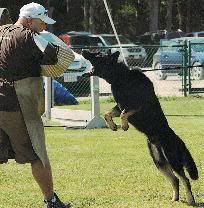Hi Dave and welcome.
I'm sorry about your encounter with those money-sucking trainers.
Believe it or not, your problem is an easy one to fix by using the dog's pack drive to your advantage.
The important thing to keep in mind here is that if you can get the dog to respect and to trust you entirely as pack leader, she won't feel the need to put up all this aggression when she feels vulnerable.
First, make sure that you don't ever allow another dog to approach her (no matter how friendly it may seem). If you encounter loose dogs on walks, it's your job as pack leader to step in between your girl and the other dog and to drive the other dog away.
This alone will go a huge way towards alleviating her fears. If she sees you as a strong pack leader who steps in at the first sign of trouble (from her point of view, other dogs are scary and dangerous) she'll learn that she can trust you to keep her safe and this will take the burden of fear off her mind.
This continues for the life of the dog.
The second step is to correct her for showing aggression. Remember, you're the pack leader, not her. The leader is the one who decides when and where to show aggression. If you tell her to stop being aggressive and she ignores you, she doesn't respect you as her leader (it doesn't matter if she's doing this out of fear or out of dominance, you correct the same way).
In order to correct her, you pretty much have two options: either use a prong collar, or use a dominant dog collar (a nylon choke collar).
1. If you use a prong collar: make sure it's fitted properly.
Click here to see how to do that if you don't already know.
When your dog shows aggression to another dog, tell her NO in a calm firm voice. If she ignores your verbal warning, give her a jerk on the leash. Be careful you don't over correct to the point of traumatizing her, but also make sure you don't give a nagging and ineffective correction.
If she ignores the prong collar correction, your correction was too weak. The response you want is for her to immediately break off eye contact with the other dog (she'll probably let out a little yelp) and to come back to your side and pay attention to YOU.
Once she does, don't fuss over her. Stay as aloof and relaxed as you can (don't tense up on the leash!!); remember, as Heather said, you have to show her by your own behaviour that the appropriate response is to stay calm.
You can give her one quiet "that's better" to reassure her, but otherwise, just go on with your walk and act completely unconcerned with the situation or with her reaction.
2. If you use a nylon choke collar: again, make sure it's fitted properly. The collar should be snug and fit high on the neck.
When your dog shows aggression, once again, tell her NO first and give her 2 or 3 seconds to do the right thing.
If she ignores your warning, DON'T pop the leash, but quietly lift the leash straight up above her head so that the collar tightens around her neck.
Put enough pressure that you pick her front feet an inch or two off the ground and hold her there until she stops the aggression.
Do this as CALMLY as you possibly can. Remember, by cutting off her air supply, you're showing her that you're in control and that it's you that she should be focusing on, not the other dog.
Whichever form of correction you choose, it's important that you not wait until the other dog is walking up to her and she starts freaking out. Otherwise it'll take a much higher level of correction to get her attention.
When she sees a dog on the other side of the street and you can see her focusing on it (but not out of control yet), give her the warning (NO) and follow (within 3 seconds) with a leash correction. If you do this right, she'll come back to you and will knock off the aggression.
As you progress, you should quickly reach a point (probably within a couple of sessions) where a simple NO will cause her to break off eye contact with a dog on the other side of the street.
You can then slowly move on to a more difficult situation, where the other dog is a little bit closer. Eventually, she should be able to stay focused on YOU even with another dog only feet away (this might take a while, but it's not hard to accomplish).
Don't rush this, and don't forget to keep up your end of the deal. She leaves you in charge to deal with threatening situations, but in return you MUST protect her from other dogs.
Don't worry about offending anyone. If someone can't keep their dog under control, raise your voice at the dog and tell it to GET LOST. Charge the other dog if you have to. This is usually all it takes to get dogs to back off and leave you alone.
If you ever encounter a really aggressive or persistent dog, kick it or mace it if you have to.
If the owner complains to the police, tell them that you were fearing for your OWN safety (not your dog's) and that you thought you were about to be attacked. You have the right to defend yourself and you won't get into trouble for that.
Best of luck, Dave

If you ever want to watch a demonstration of the techniques I mentioned, you can get Ed Frawley's "Dealing with Dominant and Aggressive Dogs" DVD. While your dog may not be dominant at all, the methods for solving dog-on-dog aggression issues are very clearly demonstrated and explained.
 Previous Topic
Previous Topic Index
Index Next Topic
Next Topic











 Top
Top








.jpg)
